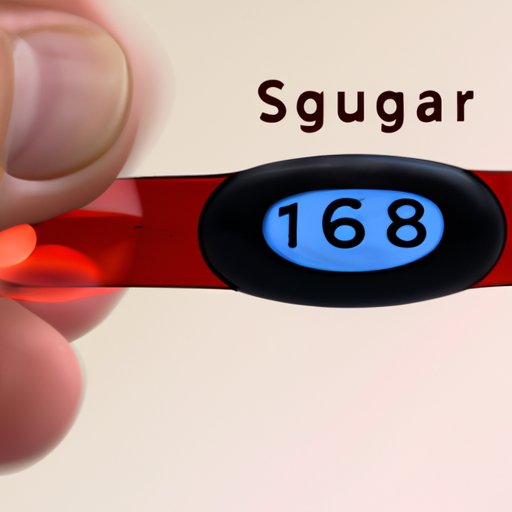
Introduction
Blood glucose control is crucial for individuals with diabetes to lead a healthy, stable life. Many people with diabetes have questions about how much their blood sugar drops after exercise. Understanding the phenomenon of blood sugar drops after exercise is essential to manage diabetes effectively.
The aim of this article is to address the importance of blood sugar control after exercise and provide valuable information on blood sugar management during exercise. We will explore the science behind blood sugar drops after exercise, including factors that affect blood sugar levels, and provide guidance on effective workout routines.
The Science Behind Blood Sugar Drop After Exercise: Understanding the Phenomenon and Why It Matters
Exercise involves our muscles using glucose as fuel, which can lead to temporary drops in blood sugar levels.
The pancreas, which controls insulin secretion in our body, responds to the muscle’s glucose demand by providing insulin to transport glucose into muscles. As a result, insulin levels decrease, which prevents a build-up of sugar in the bloodstream, leading to a lower blood glucose reading post-exercise.
However, for people with diabetes, this process may not function correctly. The outcome can lead to blood sugar spikes or drops, with potentially serious consequences. Stable blood sugar levels are critical for diabetes management’s overall health.
How Long Does It Take for Blood Sugar to Drop After Exercise? A Comprehensive Look at Different Factors
Several factors impact how long it takes for blood sugar to drop after exercise. The intensity and duration of the workout, the body’s response to insulin, and the timing of meals and medication all play a crucial role.
The type of physical activity, such as cardiovascular exercise and weightlifting, can affect blood sugar levels differently. For instance, cardiovascular exercise can lead to a faster drop in glucose levels than weightlifting because it uses energy more quickly.
In addition to physical activity level and timing, meal timing and insulin levels significantly impact blood sugar immediately after exercise. Going for a workout on an empty stomach leads to a higher drop in blood glucose compared to exercising after a meal. Similarly, it is essential to monitor insulin levels while performing any physical activity.
From Spikes to Dips: The Effect of Different Exercises on Blood Sugar Levels
As previously mentioned, different forms of exercise can impact blood glucose levels differently. Cardiovascular exercise, like cycling, running, or swimming, tends to lower blood glucose levels. Thus, people who engage in cardiovascular exercise should closely monitor their blood glucose levels during and after exercise.
Weightlifting or strength training might increase glucose levels due to the adrenaline released during lifting. This increase is temporary and should not deter people with diabetes from engaging in this form of exercise. Instead, individuals should monitor their blood glucose levels and adjust their exercise routine accordingly.
Individuals with diabetes should choose exercises based on their individual goals, current blood glucose levels and take proper precautions to ensure safety while engaging in physical activity.
How to Use Exercise to Control Blood Sugar Levels: Tips and Tricks for Diabetic Patients
Exercise is a crucial tool in diabetes management. It can help increase insulin sensitivity and reduce body weight, leading to better blood sugar control. Combining physical activity with healthy eating and medication is the foundation of a successful management plan.
The American Diabetes Association recommends 150 minutes of moderate-intensity exercise per week. Individuals should aim to incorporate a combination of cardiovascular exercise and weightlifting to achieve optimal blood glucose control.
It is also essential to understand the impact of food intake on blood glucose and how to balance it with exercise effectively. Individuals should aim to consume a carbohydrate-rich snack before engaging in exercise, especially weightlifting, to prevent low blood glucose.
Lastly, it is vital for individuals with diabetes to monitor blood glucose levels before and after workouts and adjust their diabetes management plan accordingly.

Breaking Down the Numbers: Studying the Magnitude of Blood Sugar Drops After Exercise
Research studies have shown that the intensity and duration of exercise can have a significant impact on the magnitude of blood sugar drops. For example, a study conducted with type 2 diabetes patients showed that 60 minutes of moderate-intensity exercise led to a blood sugar decrease of 24 percent.
Another study indicated that high-intensity interval training led to a more substantial blood glucose drop (35 percent) than continuous, moderate-intensity exercise (24 percent). However, it is important to recognize that individual responses to exercise vary considerably from one person to another, so careful monitoring, including by a medical professional, is important.
The Importance of Timing and Intensity: How to Optimize Your Workout Routine to Lower Blood Sugar Levels
Optimizing exercise routines to lower blood sugar levels requires understanding the factors that impact their effectiveness. It is essential to time exercise routines properly, such as exercising after a meal when glucose levels are high or monitoring glucose levels regularly during endurance exercise.
Increasing the intensity of physical activity can also lead to a more significant drop in blood glucose levels. However, individuals should ensure that they are comfortable with increased intensity levels before making adjustments. Any new workout routine should be discussed with a doctor to ensure that it is safe and effective for a person’s individual needs.
Debunking Common Myths Around Blood Sugar Drops After Exercise: Separating Facts from Fiction
Several myths exist surrounding blood sugar control after exercise. One of the most common myths is that you should avoid exercise if you have diabetes. However, appropriate and regular exercise is a crucial aspect of diabetes management.
Another myth is that only aerobic exercise can help control blood glucose levels. However, weightlifting or resistance training can also improve blood glucose levels and overall health.
It is essential to dispel these common myths and understand the scientific evidence behind diabetes management practices to achieve optimal blood glucose control.
Conclusion
Blood sugar control is a key aspect of diabetes management. Understanding the impact of exercise on glucose levels is crucial for individuals with diabetes to lead a healthy and stable life. By providing valuable information on blood sugar drops after exercise, effective workout routines, and real-world success stories, we hope this article has helped readers optimize their diabetes management plan and feel confident in engaging in physical activity regularly.




